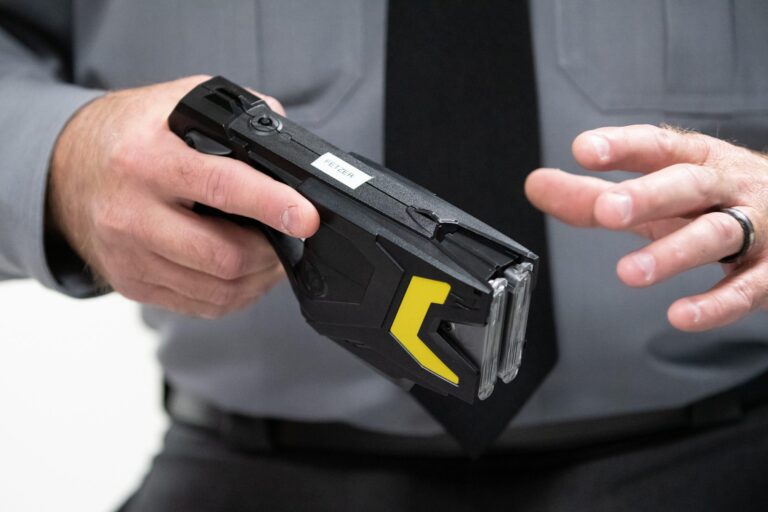Table of Contents
- Controversial Deployment Tactics and Allegations of Excessive Force
- Examining the Impact of Stun Guns on Vulnerable Populations
- Legal Challenges and Policy Gaps in Police Use of Stun Guns
- Recommendations for Enhanced Training and Accountability Measures
- Future Outlook
Controversial Deployment Tactics and Allegations of Excessive Force
In recent years, the use of stun guns by law enforcement has sparked heated debates, particularly concerning the tactics employed during deployments. Critics argue that officers sometimes resort to these devices prematurely or in situations where alternative, less aggressive methods might be more appropriate. Questions have risen over the inconsistent application of stun guns, with some encounters escalating tension rather than defusing it. This disparity in deployment practices has led to allegations that stun guns are not always used as a last resort but rather as a routine tool, contributing to unnecessary physical and psychological harm.
Concerns over excessive force have been compounded by several high-profile incidents where stun gun use has coincided with serious injury or even death. Civil rights advocates emphasize that stun guns, while marketed as non-lethal, can cause significant harm, particularly when used repeatedly or on vulnerable individuals. Key points raised in the debate include:
- Lack of standardized training on when and how to deploy stun guns appropriately.
- Disproportionate impact on minority communities, fueling distrust towards police.
- Insufficient accountability mechanisms following stun gun deployment incidents.
These factors have propelled calls for tighter regulations, enhanced oversight, and transparent reporting to ensure that stun guns serve as a controlled and justified measure within the use-of-force continuum.
Examining the Impact of Stun Guns on Vulnerable Populations
Vulnerable populations, including individuals with mental health conditions, the elderly, and those with physical disabilities, face disproportionate risks when stun guns are deployed. Studies indicate that the physiological effects of electronic control weapons may exacerbate pre-existing health issues, leading to severe outcomes that extend beyond immediate pain or incapacitation. The shock delivered can trigger cardiac complications, respiratory distress, or neurological responses that are significantly more dangerous for these groups. Medical experts and human rights advocates have raised alarms about the lack of tailored protocols to mitigate these risks during police interventions.
Beyond physical risks, the psychological trauma from stun gun use on vulnerable individuals can have lasting consequences. This demographic often encounters systemic challenges in accessing adequate mental health care, and the experience of being subjected to electric shocks by law enforcement can intensify feelings of fear, helplessness, and mistrust in public institutions. Advocates call for comprehensive policy reforms, emphasizing alternative de-escalation techniques and specialized training for officers to recognize and appropriately respond to the needs of these populations. Key recommendations include:
- Enhanced screening for vulnerability factors prior to stun gun deployment
- Improved data collection on incidents involving at-risk groups
- Mandated post-incident medical evaluations
- Implementation of non-violent crisis intervention strategies
Legal Challenges and Policy Gaps in Police Use of Stun Guns
Despite their widespread adoption, stun guns remain mired in legal controversies primarily due to ambiguous regulations governing their deployment. Jurisdictions vary significantly in defining the circumstances under which stun guns may be used, leading to inconsistent enforcement and judicial outcomes. This legal fragmentation poses challenges for accountability, as police officers may exploit these gaps to justify excessive or improper use of force. Moreover, the lack of standardized reporting requirements for stun gun deployments hinders comprehensive data collection, complicating efforts to assess their impact on public safety and civil rights.
Policy gaps further exacerbate these challenges, with many agencies lacking clear guidelines on critical issues, such as:
- Indications for Use: Defining permissible scenarios, especially in cases involving vulnerable populations like children or those with disabilities.
- Training Standards: Establishing rigorous qualification and refresher requirements for officers handling stun guns.
- Post-Use Protocols: Mandating medical evaluation and timely reporting following any deployment.
Without decisive policy intervention, these uncertainties threaten to undermine trust in law enforcement practices and raise critical questions about civil liberties in the use-of-force landscape.
Recommendations for Enhanced Training and Accountability Measures
To mitigate the risks associated with stun gun deployment, law enforcement agencies should adopt rigorous training protocols that emphasize de-escalation techniques and proper device usage. Regular scenario-based exercises can ensure officers respond effectively under stress, reducing unnecessary reliance on stun guns. Moreover, training must be standardized across jurisdictions to promote consistency and accountability, incorporating updates from the latest research on stun gun impact and safer alternatives.
Establishing transparent oversight mechanisms is equally critical. Departments ought to implement comprehensive data collection systems that document every stun gun discharge, coupled with independent review boards to assess use-of-force incidents. Key measures should include:
- Real-time recording of stun gun activations and contextual officer reports
- Mandatory body camera footage review in conjunction with deployment reports
- Community involvement in oversight panels to rebuild public trust
- Clear disciplinary frameworks tied to misuse or reckless application of stun guns
Future Outlook
As debates over the appropriate use of stun guns in law enforcement continue, it remains clear that striking a balance between officer safety and civil rights is a complex challenge. Ongoing scrutiny, legal battles, and calls for clearer policies underscore the need for transparency and accountability in the deployment of these devices. Moving forward, policymakers and law enforcement agencies will need to engage in careful evaluation and dialogue to address public concerns and ensure the responsible use of stun guns in police interactions.Check Our Other Blogs
- StunGun – Your Trusted Source for Stun Guns, Laws, and Self-Defense Tips
- PepperSprayLaws – Your Trusted Resource for Pepper Spray Information
- StunGunLaws – Your Trusted Guide to Stun Gun Legality and Safety





